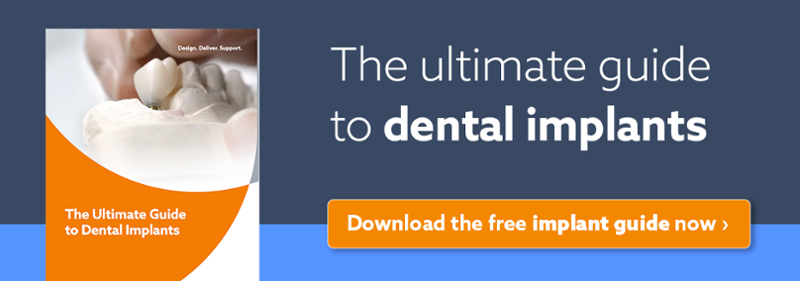Bruxism (teeth grinding and clenching) is generally considered a contraindication for dental implants, although the evidence for this is usually based on clinical experience only. There is generalized agreement that excessive stress to the bone-implant boundary may result in implant overload and failure. In a recent study published in 2018 in the Netherlands, nine practicing oral implantologists were interviewed to hear their individual opinion on how they dealt with bruxism within their daily clinical practice. A thematic analysis was conducted using a framework-based approach to explore how accredited oral implantologists work with bruxism cases within daily clinical practice.
What is Bruxism?
Bruxism is defined as the unconscious gnashing, grinding, or clenching of the teeth. The forces involved are much heavier and more forceful than normal masticatory loads. As a result of constantly exercising the muscles of mastication, patients who brux develop a greater maximum bite force than patients who do not brux. For bruxers, loads on the teeth may exceed 500 psi. Bruxism may affect patient’s teeth, muscles, joints, bone, implants, and the prostheses. These forces can occur while the patient is awake or asleep and can last for several hours a day.
In dental restorative treatment, bruxism is the usual scapegoat for implant failures. Regarding dental implants, it has been suggested that bruxism can lead to technical and biological complications even if no current evidence exists to prove this.
Objective of the Study
The study was designed to gather a broad spectrum of information about bruxism by conducting semi-structured interviews with nine men who practice oral implantology in non-academic clinical practices in the Netherlands.
Thematic Analysis
Out of the thematic analysis, four main themes emerged, which coincided with the four domains that were described by the expert panel prior to the interviews:
-
Bruxism and implant treatment outcomes.
Interviewees considered bruxism damaging for the dentition, as it can cause tooth wear, fractures of teeth and restorations, endodontic pathology, loss of teeth, pain, and limitation of mandibular movement. Some interviewees advocated that bruxism is generally not a contraindication for implant dentistry and had positively strong attitudes regarding the feasibility of implant dentistry in bruxing patients. In contrast, some expressed negativity and discomfort about performing implant treatments in bruxing patients, particularly when it came to clenching activity.
-
Treatment aspects of implantological interventions.
In the context of treatment planning, implantologists found it important to pay close attention to intraoral signs of heavy mandibular function from the start of the therapeutic trajectory. Taking time to observe signs of function, such as wear facets, was important, and implantologists should similarly try to understand why certain teeth may have fractured in the past. Taking intraoral photographs and discussing them with the patients was also considered extremely helpful. In order to increase the awareness of patients on their bruxing behavior, interviewees took time for discussion, used intraoral photographs, and had the patients feel the fremitus of their teeth. By raising awareness, patients might be more inclined to accept possible future complications, not put the blame on the implantologists, and be more compliant with the preventive advice given.
-
Diagnosis of bruxism.
Opinions about the importance of diagnosing bruxism in the implantologist’s practice diverged. On one hand, it was mentioned that knowing whether or not the patient bruxes is very important and should be investigated routinely. On the other hand, it was mentioned that bruxism occurs in virtually everyone, and it is not important to know if someone is active, but instead to make an effort to understand the multiple reasons of why restorations or teeth fracture or otherwise fail in the mouth.
-
Improvement of care in the future.
As for which component in the education of dentists could help improve the care for bruxing patients, there was a focus on the importance of proper occlusion and articulation, since it may prevent future complications. Furthermore, general dentists should learn to at least see the signs of bruxism, and to take this into account when planning their treatments. If diagnostic methods were to be improved for bruxism, their main feature should be simplicity in use. The example of a chair-side screening tool was given, allowing the dentist to track changes of the oral situation indicative of bruxism during the periodic preventive check-up, and guiding the decision to use a more thorough diagnostic method.
Conclusion: Is Bruxism a Contraindication for Implants?
The findings of this study suggest that treating bruxing patients with dental implants in the practices of accredited oral implantology specialists in the Netherlands is generally well accepted. Complications can occur, and treatment planning should be careful, but bruxism is not considered a contraindication for implant treatment. Variability appears to exist in opinions regarding bruxism diagnosis, the mechanism of biological complications, and treatment planning approaches.
To learn more about a variety of treatment plans for your bruxing patients, speak to a DDS Lab clinician today.
Click here to schedule a consultation with our technical team »

References:
https://www.nature.com/articles/s41405-018-0006-4#Abs1
https://www.ncbi.nlm.nih.gov/pubmed/16457676
https://www.dentistrytoday.com/implants/1277